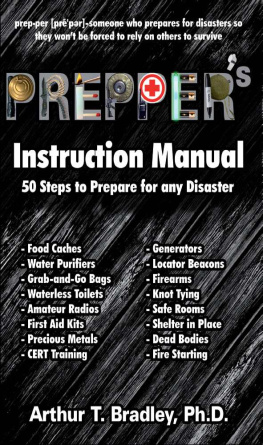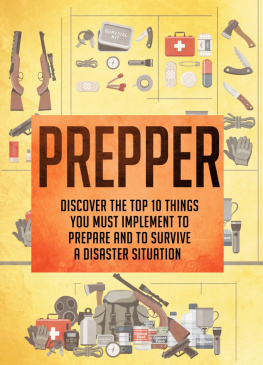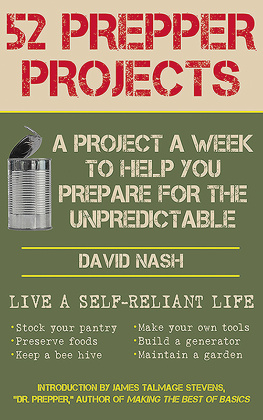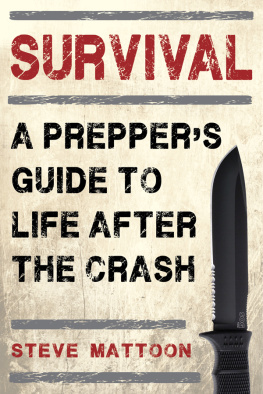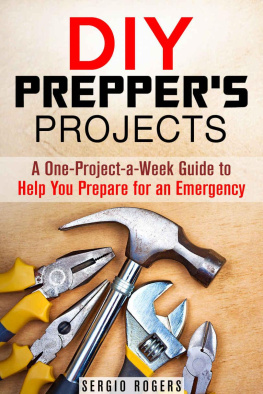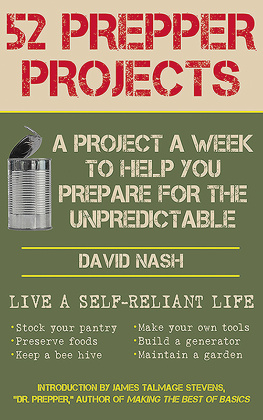
Text copyright 2015 Bernie Carr. Concept and design copyright 2015 Ulysses Press and its licensors. All rights reserved. Any unauthorized duplication in whole or in part or dissemination of this edition by any means (including but not limited to photocopying, electronic devices, digital versions, and the Internet) will be prosecuted to the fullest extent of the law.
Published in the US by:
Ulysses Press
P.O. Box 3440
Berkeley, CA 94703
www.ulyssespress.com
ISBN: 978-1-61243-514-5
Library of Congress Control Number: 2015937560
10 9 8 7 6 5 4 3 2 1
Acquisitions editor: Keith Riegert
Managing editor: Claire Chun
Editor: Renee Rutledge
Proofreader: Lauren Harrison
Indexer: Sayre Van Young
Front cover design: Rebecca Lown
Interior design: what!design @ whatweb.com
Cover artwork: pistols Orfeev/shutterstock.com, bushcraft icons zelimirz/shutterstock.com, camping icons Panptys/shutterstock.com, survival kit icon supirloko89/shutterstock.com, penny Pete Spiro/shutterstock.com
Layout: Lindsay Tamura
Illustrations: Evan Wondolowski
Distributed by Publishers Group West
PLEASE NOTE: This book is independently authored and published and no sponsorship or endorsement of this book by, and no affiliation with, any trademarked events, brands or other products mentioned or pictured within is claimed or suggested. All trademarks that appear in this book belong to their respective owners and are used here for informational purposes only. The authors and publisher encourage readers to patronize the quality events, brands and other products mentioned and pictured in this book.
CONTENTS
I started my preparedness journey soon after Hurricane Ike in 2008. In the aftermath of the hurricane, many Houston communities were left without power for several days, roads were flooded, and food deliveries to numerous area stores were delayed. It was then that I learned that when the trucks stop coming, grocery stores quickly become emptied. I resolved to be prepared and have enough supplies to sustain my family for a few weeks in case of emergencies. I read everything I could get my hands on, online and at the library, about food storage, water purification, the best backpack to have, fire starting, emergency shelters, and all manner of gear. While living in the city, I chronicled my own family preparedness steps in my blog, Apartment Prepper. In 2010, I wrote The Preppers Pocket Guide, a book about taking small, easy steps to prepare for disasters.
Over the years I have received hundreds of emails from readers who want to know how to find extra money to spend on being prepared. A common misconception, due in part to TV shows such as Doomsday Preppers, where many of the featured individuals appear to have an unlimited source of income to pour into their preparedness and survival supplies, is that you need to have a lot of money to be prepared. In TV land that may be the case, but out in the real world, most preppers are just ordinary folks with jobs struggling to make ends meet. I wont lie, there is some outlay, and certainly a lot of prioritizing involved, but it does not have to be out of reach for average people.
With all the interest in preparedness and improving ones finances, the idea to write The Penny-Pinching Prepper was born.
WHAT ARE YOU PREPARING FOR?
If you read any emergency preparedness books or survival blogs, there is always a list of perils to be ready for, ranging in severity from a simple snowstorm to more terrifying disasters such as nuclear war or an EMP (electromagnetic pulse) that takes down the power grid. Of course there are lots of other threats in between, including natural disasters, epidemics, or economic upheavals. And lets not forget personal disasters such as job loss, divorce, and medical disability. Just thinking about all these possibilities can become overwhelming, but dont let yourself get carried away.
The best way to approach this is to consider the most common threats in your immediate area. Some areas are prone to hurricanes, earthquakes, snowstorms, tornadoes, etc. While some people may fear a natural disaster, others may feel insecure in their employment situation and feel a job loss may be imminent. What are the most likely threats facing you? Answer this question and you can start prioritizing your needs and plan your expenses.
The good news is, once you get started preparing for one thing, you will have a good foundation to be prepared for other types of disasters.
IS YOUR PARTNER ON BOARD WITH PREPARING?
This is another question you must ask. If you have not brought up the subject of being prepared with your significant other, now is the time to do so. The process of getting ready will be a lot easier if your partner shares your enthusiasm. Becoming a prepared household is a joint decision. If your partner does not share your desire to be prepared, try to understand his or her point of view. Sometimes people are resistant to being prepared because of fear or lack of understanding about the need to be prepared. Do not try to argue and be confrontational. Instead, approach the subject in terms of immediate regional threats, such as being prepared for earthquakes or hurricanes. Another good approach for parents is the idea of protecting the children and making sure they are safe in a disaster. Start slow and soon your partner will realize the benefits such as money savings from your stockpile as well as an increased feeling of security that comes from being prepared.
TIME- AND MONEY-SAVER
Since I started the journey to be more prepared, I have found lots of ways to save myself both time and money. By adopting a mindset of being ready, you will avoid lots of unnecessary expenses and wasted time. How is this possible? In the coming pages, you will find out.
HOW TO GET THE MOST OUT OF THIS BOOK
and thereafter, I will give you lots of ideas on preparing for emergencies with a small budget. The fun part is being able to make some of your own preps with stuff you already have around the house.
You can start your preparedness journey AND save money simultaneously. You dont have to do this in any order. The only thing you need to do is just get started.
This may sound like a clich, but I have to say it anyway. A great first step to saving money and getting started with being prepared is to get organized. By taking this first step, you will get your finances in order and identify your important papers by eliminating all the junk.
ELIMINATE CLUTTER
You may be wondering why a penny pinchers preparedness guide would go over the exercise of getting organized. Clutter may seem harmless enough, but it ends up costing you money in the long run. For instance:
Have you missed a credit card payment and gotten charged a late payment fee?
Have you been charged an overdraft fee because you forgot to balance your checkbook for a couple of weeks and lost track of how much you had?
How many times have you had to run to the mall and buy the first thing you spotted, at full price because you forgot someones birthday was coming up?
Do you have a huge stack of papers that you have not looked at or filed?
I have missed out on deals and allowed gift certificates to expire from being disorganized and burying these opportunities under piles of paper.
Getting organized applies to both paperwork and electronic records. Not long ago, I took my car for an oil change and ended up paying full price because I did not print the email offer for a 25 percent discount. It had gotten buried in my overly full inbox. I was really annoyed at myself and resolved not to let my inbox get that full again.
Next page

